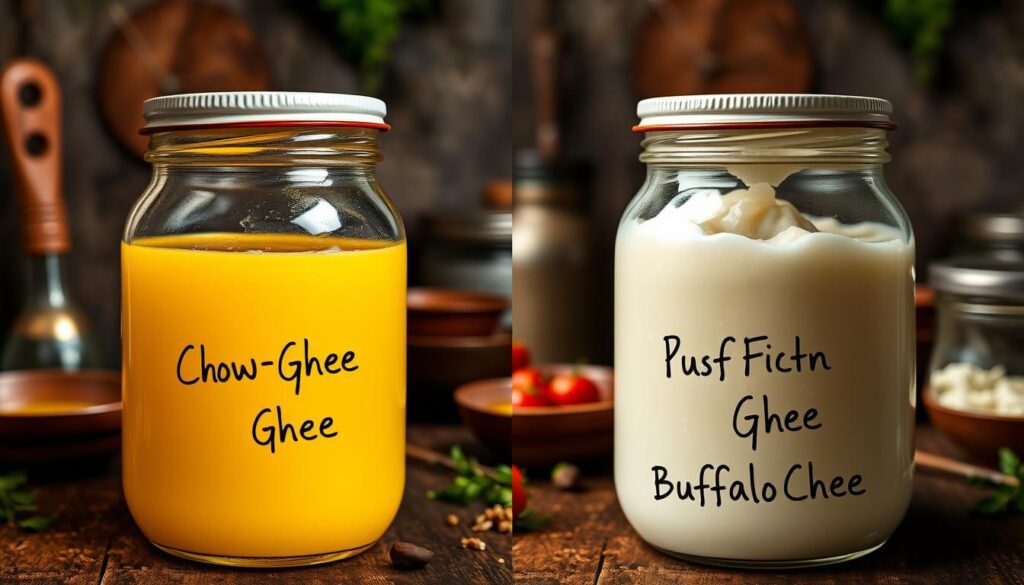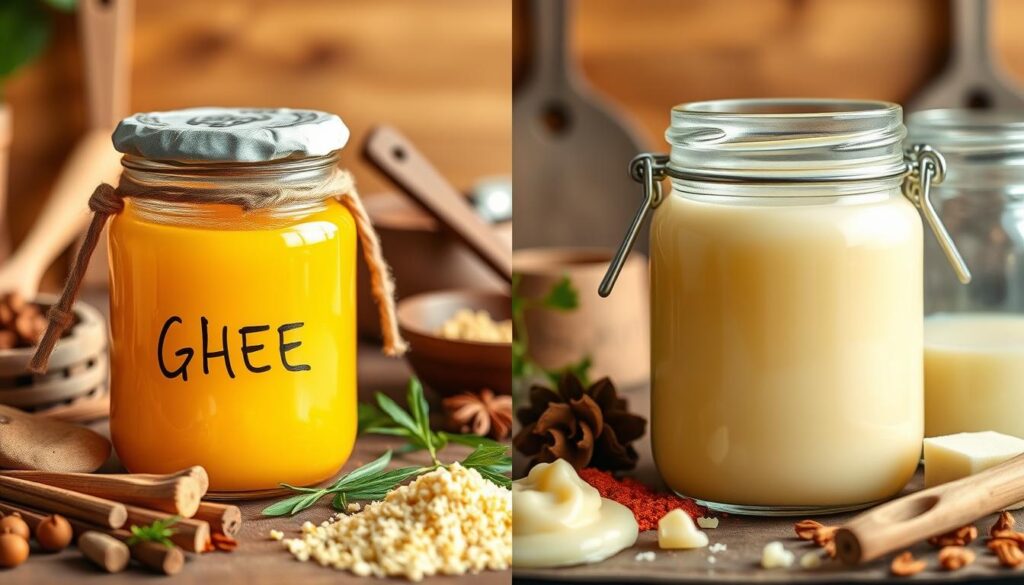The debate between Which Ghee is Better Cow or Buffalo might surprise you. Studies show buffalo milk makes more ghee than cow milk. This makes buffalo ghee a cost-effective option for many in India.
But the choice between Cow Ghee and Buffalo Ghee is more than just about money. Each type has its own nutritional benefits and uses in cooking. India, being the biggest producer and consumer of ghee, has a lot to teach us. This article will dive into the main differences between these two cooking fats.
Introduction to Ghee and Its Importance
What is Ghee?
Ghee is a cooking fat made from cow or buffalo milk. It’s made by simmering and curdling the milk. This process leaves behind a golden liquid with a rich flavor and health benefits.
Cultural and Spiritual Significance of Ghee
In India, ghee is deeply valued for its cultural and spiritual importance. It’s used in religious rituals, Ayurvedic practices, and daily cooking. It’s believed to purify the mind, body, and soul.
Ghee is also seen as a symbol of auspiciousness and prosperity. It’s used in religious ceremonies and Ayurvedic remedies. This makes it a key part of Indian culture and wellness.
| Nutritional Composition of Ghee | Cow Ghee | Buffalo Ghee |
|---|---|---|
| Fat Content | 99-99.5% | 99-99.5% |
| Saturated Fat | 46% | 52% |
| Vitamins (A, D, E, K) | Present | Present |
| Antioxidants | Present | Present |
| Medium-Chain Fatty Acids (MCFAs) | Lower | Higher |
| Conjugated Linoleic Acids (CLAs) | Lower | Higher |
The table shows the nutritional differences between cow and buffalo ghee. It highlights their unique compositions and health benefits.
Differentiating Cow Ghee and Buffalo Ghee
Cow ghee and buffalo ghee may look similar, but they have key differences. Knowing these can help you choose the right ghee for you.
Color and Texture

Cow ghee is usually yellowish. Buffalo ghee is white and creamy. This color and texture difference comes from the milk’s fat composition.
Fat Content and Yield
Buffalo ghee has more fat, with 100% saturated fat. Cow ghee has about 7.9 grams of fat per serving. Buffalo ghee makes more ghee because of its higher fat content.
Nutritional Profiles
- Cow ghee is good for the heart. It has conjugated linoleic acid for weight management and healthy metabolism.
- Buffalo ghee has more calories and fat but lacks cow ghee’s extra nutrients.
People who eat buffalo ghee usually consume more calories and fat than those who eat cow ghee.
| Attribute | Cow Ghee | Buffalo Ghee |
|---|---|---|
| Color | Yellowish | White and Creamy |
| Fat Content | 7.9 grams per serving | 100% Saturated Fat |
| Yield | Lower | Higher |
| Nutritional Benefits | Heart-friendly, Weight Management | Higher Calories and Fat |
In conclusion, cow ghee and buffalo ghee differ in more than just looks. They vary in nutritional value, fat content, and use. Knowing these differences helps you pick the best ghee for your diet and taste.
Color and Appearance
There are clear differences in how cow ghee and buffalo ghee look. Cow ghee stands out with its yellowish hue. This color comes from beta-carotene, a Vitamin A precursor found in cow milk. It shows the nutritional value of cow milk.
Buffalo ghee, on the other hand, has a white and creamy texture. Its subtle look makes it great for many recipes. It’s perfect for dishes where you want a light flavor.

The color difference between cow and buffalo ghee comes from the milk and the animals’ diet. For example, grass-fed cow milk makes ghee even more golden. This is because the grass’s beta-carotene content is passed on to the ghee.
| Characteristic | Cow Ghee | Buffalo Ghee |
|---|---|---|
| Color | Yellowish hue | White and creamy |
| Texture | Smooth and silky | Thick and rich |
| Aroma | Distinct, nutty | Mild and delicate |
The look of ghee tells us a lot about its nutrition and use in cooking. Knowing these differences helps us choose the best ghee for our needs.
Ghee Yield and Fat Content
Ghee from buffalo milk usually has a higher yield than from cow milk. This is because buffalo milk has more fat. This results in a richer, nuttier-tasting dairy product. Cow ghee is often chosen for its lower fat and higher good cholesterol, making it better for the heart.
Buffalo ghee, with its higher fat, is richer and more energy-dense. It’s a favorite for traditional Indian dishes needing a creamy texture. Cow ghee has about 7.9 grams of fat per serving. Buffalo ghee is almost all fat, lacking other nutrients.
Higher Yield from Buffalo Milk
Buffalo milk’s higher fat content means more ghee can be made. This is good for those wanting to make more ghee or save money. Buffalo ghee is known for its richer, more indulgent taste.
Cow Ghee’s Lower Fat Content
Cow ghee is often chosen for its lower fat and more cholesterol-friendly fats. It’s better for the heart, helping keep cholesterol levels healthy and supporting heart function.
| Nutritional Comparison | Cow Ghee | Buffalo Ghee |
|---|---|---|
| Fat Content (per serving) | 7.9 grams | Nearly 100% fat |
| Beneficial Nutrients | Vitamins, minerals, antioxidants | Primarily energy-dense fat |
| Suitability | Heart-friendly, weight management | Richer, more suitable for traditional dishes |
Choosing between cow and buffalo ghee depends on health needs, taste, and lifestyle. Knowing the differences in yield and fat content helps make the right choice for your diet and goals.
Health Benefits and Nutritional Composition

Cow ghee and buffalo ghee both have their own health benefits. Cow ghee is good for the heart because it has less fat and cholesterol than buffalo ghee. It also has vitamins A, D, E, and K, and minerals like calcium and protein.
Buffalo ghee, on the other hand, is great for bones because it has lots of calcium, magnesium, and phosphorus. It also has more energy, which is good for people who need more power or want to gain weight. But, buffalo ghee is all fat and doesn’t have as many nutrients as cow ghee.
| Nutritional Aspect | Cow Ghee | Buffalo Ghee |
|---|---|---|
| Saturated Fat (per serving) | 7.9 g | 100% fat |
| Vitamins and Minerals | Rich in A, D, E, K, calcium, protein | Higher in calcium, magnesium, phosphorus |
| Medicinal Benefits | Antioxidant, antifungal, antibacterial | Fewer medicinal benefits |
| Energy Density | Lower calorie content | Higher calorie content |
Choosing between cow ghee and buffalo ghee depends on your health needs. Cow ghee is better for weight control and sensitive stomachs. Buffalo ghee is great for those who work hard or are athletes needing more energy. Pick the ghee that fits your health goals and taste preferences.
Shelf Life and Storage
There are big differences in the shelf life and storage of cow and buffalo ghee. Buffalo ghee lasts longer because it has more fat. This fat helps it stay good for a long time. Cow ghee, on the other hand, should be used within 3-6 months because it can go bad faster.
Buffalo ghee lasts longer because it has a lot of saturated fat, up to 82%. Cow ghee has less fat, about 7-8%. This means buffalo ghee stays fresh longer, while cow ghee goes bad sooner.
Storing Ghee for Optimal Freshness

To keep cow and buffalo ghee fresh, store them right. Use airtight containers and keep them away from sunlight and heat. Refrigeration helps keep them fresh and full of nutrients for a longer time.
Knowing how to store cow and buffalo ghee helps you enjoy their health benefits longer. By following the right storage tips, you can keep these fats fresh for a longer time.
Suitability for Children and Weight Management
Choosing between cow ghee and buffalo ghee depends on health and dietary needs. For kids, cow ghee is better because it has less fat. It also helps with healthy growth and development.
Cow ghee for children is suggested by health experts. It’s full of vitamins, minerals, and healthy fats. These are key for a child’s health. Cow ghee is also good for the heart because it has less saturated fat than buffalo ghee. It also has butyrate, which helps with digestion and the immune system.
For weight management, cow ghee for weight loss is a good choice. It has less fat, which helps with losing weight and staying fit. It also gives important nutrients. On the other hand, buffalo ghee for weight management is better for those who need more energy or want to gain weight. It has more calories.
| Characteristic | Cow Ghee | Buffalo Ghee |
|---|---|---|
| Fat Content | Lower fat content | Higher fat content |
| Suitability for Children | Recommended for children’s growth and development | Not as suitable for children due to higher fat content |
| Suitability for Weight Management | Beneficial for weight loss and maintaining a healthy weight | Suitable for weight gain and maintaining energy levels |
The right choice between cow ghee and buffalo ghee depends on your health goals and diet. Talking to a healthcare professional can help pick the best option for kids and those trying to manage their weight.

Culinary Applications and Versatility
Cow ghee and buffalo ghee are two types of clarified butter. They are highly valued in cooking. Each has its own uses in the kitchen, thanks to their unique qualities.
Cow Ghee for Sweets and Light Dishes
Cow ghee is great for making sweets. It’s used to make treats like halwa, barfi, and gulab jamun. It also adds a sweet and nutty flavor to light dishes, such as dals and vegetable stir-fries.
Buffalo Ghee for Heavier Curries and Paneer
Buffalo ghee is perfect for rich dishes. It makes curries and sauces creamy. It’s also good for cooking paneer, a favorite Indian cheese. Its thick texture is great for dishes that need a rich feel.
| Characteristics | Cow Ghee | Buffalo Ghee |
|---|---|---|
| Smoke Point | 450°F to 485°F | 400°F to 450°F |
| Flavor Profile | Buttery, sweet, and nutty | Robust, tangy, and nuttier |
| Texture | Smooth and creamy | Denser and creamier |
| Calorie Content | 123 kcal per tablespoon | 134.6 kcal per tablespoon |
Cow ghee and buffalo ghee are versatile in cooking. Cow ghee is best for sweets and light dishes. Buffalo ghee is great for rich curries and paneer. They show the unique qualities of each type of clarified butter.

Which Ghee is Better Cow or Buffalo
Choosing between cow ghee and buffalo ghee is a personal decision. Both have their own benefits. Many people prefer cow ghee for its health benefits and suitability for all ages.
Cow ghee is known for being good for the heart. It has less saturated fat than buffalo ghee. It also has important vitamins, minerals, and antioxidants, making it a healthier choice. On the other hand, buffalo ghee is more energy-dense. It’s better for those who want to gain weight or need more calories.
- Cow ghee is good for kids and those trying to lose or gain weight because of its lower fat content.
- Buffalo ghee lasts longer than cow ghee because it has more fat.
- Cow ghee costs more than buffalo ghee. This is because cow milk makes less ghee.
The choice between cow ghee vs. buffalo ghee depends on your diet and health goals. Cow ghee is often seen as better, thanks to its health benefits and suitability for all ages.
In Ayurvedic practices, cow ghee is used for treatments like Nasya. Buffalo ghee is used less often. This shows cow ghee is more versatile and beneficial for ghee consumption.
Ayurvedic Uses and Medicinal Properties
In Ayurvedic medicine, cow ghee and buffalo ghee are highly valued. They offer many health benefits and are used in various ways. Cow ghee is more popular, but buffalo ghee also has great medicinal properties.
Cow Ghee in Ayurvedic Nasya Treatment
Cow ghee is often used in Nasya treatment. It’s put into the nasal passages. This ghee is full of vitamins and antioxidants.
It’s believed to help with hair loss, headaches, and vision problems. The nutrients in the ghee are absorbed through the nose. This helps restore the body’s health.
Cow ghee is also good for the liver, joints, and fighting infections. This is because of its nutrients and anti-inflammatory effects.
Buffalo ghee is less used but very nutritious. It has CLAs and MCFAs. These help with weight and heart health.
| Nutrient | Cow Ghee (1 tbsp) | Buffalo Ghee (1 tbsp) |
|---|---|---|
| Calories | 130 | 130 |
| Protein | 0 g | 0 g |
| Fat | 15 g | 15 g |
| Carbohydrates | 0 g | 0 g |
| Vitamin E | Excellent source | Excellent source |
Cow and buffalo ghee have special medicinal properties. Cow ghee is often used, like in Nasya treatments. Buffalo ghee is good for weight and heart health. Both are valuable in Ayurvedic medicine.
Conclusion
Cow Ghee and Buffalo Ghee both have their own benefits. They can be part of a healthy diet. The choice between them depends on your health needs, what you like to eat, and Ayurvedic practices.
Cow Ghee has less fat but more good fats, vitamins, and compounds like CLA and butyrate. It’s great for those who want a healthier, easier-to-digest oil. Buffalo Ghee, with its richer taste and higher calories, is better for those who need more energy, like athletes or people with active jobs.
Choosing between Cow Ghee and Buffalo Ghee should match your health goals, taste, and Ayurvedic beliefs. Adding the right ghee to your meals can bring rich flavors and health benefits. It’s a traditional Indian superfood with cultural importance.




